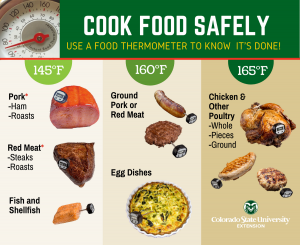 Using frozen foods can be a great way to get a quick meal on the table. Correctly preparing frozen foods not only maximizes nutrition and flavor but also helps prevent foodborne illness. Unfortunately, it can be easy to overlook safe preparation when a frozen product already has grill marks on it and looks ready to just bite into!
Using frozen foods can be a great way to get a quick meal on the table. Correctly preparing frozen foods not only maximizes nutrition and flavor but also helps prevent foodborne illness. Unfortunately, it can be easy to overlook safe preparation when a frozen product already has grill marks on it and looks ready to just bite into!
Keep frozen foods safe and delicious:
- Read the package to determine if the frozen product should be cooked or is ready-to-eat.
- When something like frozen chicken is breaded, has grill marks or is partially cooked, it can be hard to tell if it is still raw. Read the packaging to double-check, keeping an eye out for
 phrases that indicate you need to cook the product, like “Cook and serve,” or “Ready to cook.”
phrases that indicate you need to cook the product, like “Cook and serve,” or “Ready to cook.”
- When something like frozen chicken is breaded, has grill marks or is partially cooked, it can be hard to tell if it is still raw. Read the packaging to double-check, keeping an eye out for
- Wash your hands.
- Handwashing is essential before and after meal preparation. Wash with soap and water, scrubbing well, for at least 20 seconds.
- Use a food thermometer to make sure frozen foods are cooked to a safe temperature before eating.
- Just like preparing non-frozen foods, it is important to cook frozen foods to the same safe internal temperatures shown in the ‘Cook Food Safely’ chart.
Use the following frozen items to make flavorful snacks and meals: 
- Fruits: Keep fruits on hand to make smoothies or simple, tasty treats such as fruit cobblers.
- Vegetables: Stock up on vegetables for making a quick stir-fry, fried rice, or for adding to soups and stews.
- Hash-browns: Mix hash-browns with cheese and other ingredients such as vegetables or meat to make a easy and tasty potato casserole.
- Dumplings or filled pasta: Add prepared dumplings to chicken or other broth for an easy wonton soup.
- Whole grain waffles: Whip up a tasty breakfast sandwich or a BLT instead of using bread.
- Meatballs: Add marinara sauce and cheese and serve on bread for a meatball sub or mini meatball sliders. Consider using with other types of sauce to create your own dish.
Other tips:
- Check for recalls. Sometimes, frozen foods are recalled due to safety concerns such as contamination from bacteria, virus or allergens. FoodSafety.gov has information about recalls and how to handle the recalled product.
- Mix frozen and fresh. Have some unused herbs from last night’s recipe? Toss them with frozen ingredients to boost color and add another layer of flavor.
Learn more about the advantages of preparing canned and frozen fruits and vegetables. Explore CSU Extension’s Preserve Smart app/website for instructions on freezing your favorite fruits and vegetables.
One last thing – we would love for you to leave a comment on your favorite, tried-and-true frozen food hacks!


Love to see the food safety tips along side ideas for quick and nutritious meals!